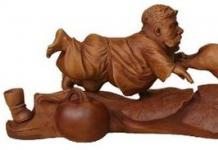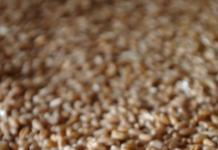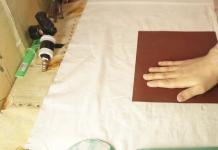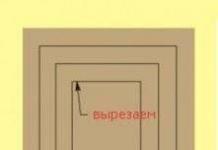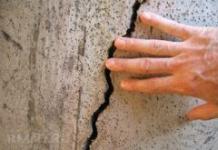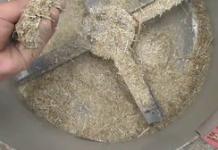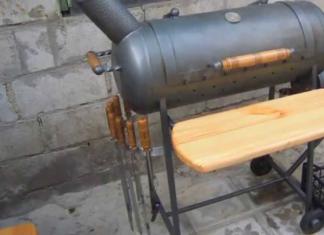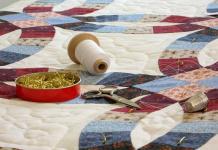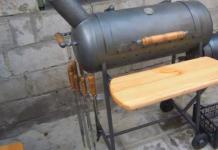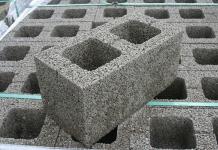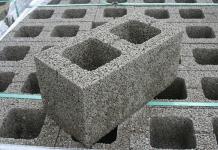Polytetrafluoroethylene, teflon or fluoroplast -4(-C 2 F 4 -) n - polymer of tetrafluoroethylene (PTFE), plastic, which has rare physical and chemical properties and is widely used in technology and in everyday life.
The word "Teflon" is a registered trademark of the DuPont Corporation. The generic name for the substance is "polytetrafluoroethylene" or "fluoropolymer". In the USSR and Russia, the traditional technical name for this material is fluoroplast.
Polytetrafluoroethylene was discovered in April 1938 by 27-year-old chemist Roy Plunkett of Kinetic Chemicals, who accidentally discovered that gaseous tetrafluoroethylene pumped into pressurized cylinders by him spontaneously polymerized into a white paraffin-like powder. In 1941 Kinetic Chemicals was granted a patent for Teflon and in 1949 became a division of the American company DuPont.
Properties
Physical
Teflon is a white, transparent substance in a thin layer, resembling paraffin or polyethylene in appearance. Density according to GOST 10007-80 from 2.18 to 2.21 g / cm 3. It has high heat and frost resistance, remains flexible and elastic at temperatures from -70 to +270 °C, excellent insulating material. Teflon has very low surface tension and adhesion and is not wetted by water, fats or most organic solvents.
Fluoroplast is a soft and fluid material, therefore it has limited application in loaded structures. It has very low adhesion (stickiness).
DuPont specifies melting point according to ASTM D3418 for different types of Teflon from 260°C to 327°C.
Chemical
It surpasses all known synthetic materials and noble metals in its chemical resistance. It does not collapse under the influence of alkalis, acids, and even a mixture of nitric and hydrochloric acids. It is destroyed by melts of alkali metals, fluorine and chlorine trifluoride.
Production
The production of polytetrafluoroethylene includes three stages: at the first stage, chlorodifluoromethane is obtained by replacing chlorine atoms with fluorine in the presence of antimony compounds (Swarts reaction) between trichloromethane (chloroform) and anhydrous hydrogen fluoride; in the second stage, tetrafluoroethylene is obtained by pyrolysis of chlorodifluoromethane; in the third stage, the polymerization of tetrafluoroethylene is carried out.
F-4 products are produced by cold pressing followed by baking at a temperature of 365±5 °C. The pressing process proceeds from an aqueous emulsion of PTFE in the presence of a surfactant (for example, perfluorooctanoic or perfluorooctanesulfonic acid), which stabilizes the emulsion and makes it possible to produce water-dispersed polytetrafluoroethylene.
The main manufacturer of fluoroplast in Russia is the Kirovo-Chepetsk chemical plant named after Konstantinov, Kirovo-Chepetsk, Kirov region.
Application
Industry and technology
Due to its chemical inertness, hydrophobicity and fluidity, the material is widely used for sealing threaded and flanged joints (FUM tape).
Lubricant
Fluoroplastic (Teflon) is an excellent anti-friction material with a coefficient of sliding friction, the smallest of the known structural materials available (even less than that of melting ice). Because of their softness and fluidity, solid PTFE plain bearings are rarely used. In highly loaded units, metal-fluoroplastic bearings-inserts and metal-fluoroplastic support tapes are used. Such a sliding element can withstand tens of kilograms per square millimeter and consists of a metal base, on which a fluoroplastic coating is applied.
Electronics
Teflon is widely used in high-frequency technology, because, unlike polyethylene or polypropylene with similar properties, it has a dielectric constant that changes very little with temperature, a high breakdown voltage, and extremely low dielectric losses. These properties, along with heat resistance, determine its widespread use as wire insulation, especially high-voltage, all kinds of electrical parts, in the manufacture of high-quality capacitors, printed circuit boards.
In electronic equipment for special purposes, wiring with PTFE insulation, resistant to aggressive environments and high temperatures, is widely used - wires of the MGTF, MS and a number of others brands. Wire in Teflon insulation cannot be melted with a soldering iron. The disadvantage of fluoroplastic is high cold fluidity: if you keep the wire in fluoroplastic insulation under mechanical load (for example, put a furniture leg on it), the wire may become bare after a while.
Medicine
Due to its biological compatibility with the human body, polytetrafluoroethylene is successfully used for the manufacture of implants for cardiovascular and general surgery, dentistry, and ophthalmology. Teflon is considered the most suitable material for the production of artificial blood vessels and pacemakers. In 2011, for the first time, it was used for plasty of damaged nasal septum and walls of the paranasal sinuses instead of titanium meshes. After 12–15 months, the implant completely dissolves and is replaced by the patient's own tissue.
Teflon is also used in the manufacture of other household appliances. Teflon coating in the form of the thinnest film is applied to razor blades, which significantly prolongs their life and makes shaving easier.
Teflon coated cookware care
Teflon coating does not have great strength, therefore, when cooking in such dishes, only soft - wooden, plastic or plastic-coated - accessories (shovels, ladles, etc.) should be used. Teflon-coated dishes should be washed in warm water with a soft sponge, with the addition of liquid detergent, without the use of abrasive sponges or cleaning pastes. Avoid overheating and high heat.
Cloth
In the production of modern high-tech clothing, membrane materials based on expanded polytetrafluoroethylene are used.
By physical deformation of Teflon, a thin porous film is obtained, which is applied to fabrics and used in tailoring. Membrane materials, depending on the manufacturing features, can have both windproof and water-proof properties, while the normalized pore size of the polytetrafluoroethylene membrane allows the material to effectively pass the evaporation of the human body.
There is a fabric-based PTFE membrane material that allows air to pass through but does not allow wind to pass through.
- Gore-Tex is a waterproof breathable membrane fabric.
Other products
Products in the production of which Teflon is used:
|
|
The danger of polytetrafluoroethylene
The possible negative impact of polytetrafluoroethylene on human health has been the subject of controversy for many years. The polymer itself is very stable and inert under normal conditions. PTFE does not react with food, water or household chemicals.
When ingested, polytetrafluoroethylene is harmless. The World Health Organization turned to the International Cancer Control Organization with a request to conduct an experiment on rats. Experience has shown that when taken with food up to 25% polytetrafluoroethylene, it has no effect. This study was carried out in the 1960s and again in the 1980s on a general population of rats that consumed 25% of their total food intake of PTFE each day.
Research by French experts, published in the journal "60 Millions de Consomateurs" the results of a laboratory study of 13 samples of frying pans, confirm the safety of the non-stick coating. The French magazine reports that as a result of the tests, the complete safety of the pans was proved. All samples successfully passed the test after rubbing the surfaces with abrasive material a thousand times over two cycles.
Fluoroplastic is potentially biologically hazardous in two cases: during production and when the finished polymer is overheated. Polymer production uses toxic and carcinogenic substances that can enter the environment both through leakage and as industrial contamination of the finished product. When the PTFE is overheated, thermal decomposition occurs with the release of toxic substances.
Industrial pollution
The main source of biological risks in the production of fluoropolymers is considered perfluorooctanoic acid (PFOA, PFOA). This compound has been used in the USA since the 1950s. The first information about the impact on health was obtained at the factories of 3M and DuPont in the 60s. In the 80s, scientific groups joined the study of biological effects. In the late 1990s, the US regulatory authorities drew attention to the problem, which resulted in the recognition of the danger of the substance and the regulation of maximum concentrations. Technological processes in the United States have been changed to completely phase out PFOA. Large-scale campaigns have been launched to control PFOA concentrations and clarify its impact on human health.
DuPont has received hundreds of millions of dollars in legal claims from its employees and nearby residents in connection with harm to health and the silence of the dangers of production. In 2006, DuPont, by then the only manufacturer of PFOA in the US, agreed to remove residual reagent from its facilities until 2015. As of January 2012, DuPont has not used PFOA in its cookware or bakeware, according to the company's official information.
It is known that perfluorooctanoic acid decomposes at a temperature of 190 ºС, while the technological process of sintering the base of a pan with a non-stick coating occurs at a temperature of 420 ºС. Thus, it is assumed that, according to the manufacturing process, the presence of PFOA in the finished pan is unlikely. However, a 2005 study found PFOA levels in PTFE-coated new cookware ranging from 4 to 75 µg/kg (with about 1800 µg/kg in cling film and up to 290 µg/kg in popcorn packaging).
Independent European studies have shown that non-stick coatings do not contain PFOA in excess of safe limits. Chinese Academy of Quality Control, Inspection and Quarantine (GAQSIQ), Danish Institute of Technology confirm that no exposure to PFOA used in the manufacture of tableware has been detected. .
In Russia, there are no regulatory documents that limit industrial contamination of fluoroplastics, which can adversely affect the quality of products containing fluoroplastics.
Thermal decomposition of polytetrafluoroethylene
The rate of Teflon pyrolysis depends on the degree of polymerization. Signs of decomposition are found at a temperature of 200 °C. The process proceeds relatively slowly up to 420 °C. At temperatures from 500 °C to 550 °C, weight loss reaches 5-10% per hour in inert media, accelerating sharply in the presence of atmospheric oxygen. At temperatures between 300 and 360 °C, the decomposition products are predominantly hexafluoroethane and octafluorocyclobutane. Above 380 °C, perfluoroisobutylene and other pyrolysis products appear.
Among the products of thermal decomposition of polytetrafluoroethylene, perfluoroisobutylene is considered the most dangerous - an extremely poisonous gas, which is about 10 times more poisonous than phosgene.
Thermal decomposition products cause a poisoning pattern reminiscent of foundry fever. Possibly, polytetrafluoroethylene aerosol, especially freshly obtained, on which degradation products are sorbed, is also poisonous and has a pyrogenic effect. When inhaling the dust of cold polytetrafluoroethylene, after 2-5 hours, all workers experienced symptoms that were called "Teflon fever". Typical Teflon fever has been observed with PTFE heated to >350°C. When examining 130 people and the presence of polytetrafluoroethylene aerosol in the air at a concentration of 0.2-5.5 mg/m3, it was revealed that most of the workers had recurrent attacks of fever. Fluoride (0.098-2.19 mg/l) was found in the urine of the same individuals. The release of fluorine was significantly higher with longer experience and repeated attacks.
Since the mass release of toxic substances with Teflon begins at temperatures above 450 ° C, cookware with non-stick coatings is considered safe, since such temperatures cannot be reached during normal use. It should be borne in mind that manufacturers consider only heating with water or oil in a pan to be the norm. Water prevents the Teflon from overheating, and its complete evaporation indicates a significant heating of the dishes, which is now not visualized in any way and can become critical. Edible oils decompose at temperatures up to 200°C with the release of smoke, making it easier to identify overheating. Heating on a dry cookware stove is considered abnormal and in this case the Teflon pyrolysis temperatures are easily achievable. To simplify operation, some models of Teflon cookware are equipped with built-in visual temperature indicators.
Soldering wires with PTFE insulation requires mandatory exhaust ventilation.
Danger of Teflon decomposition products for birds
The special structure of the respiratory system of birds makes them hypersensitive to toxic substances contained in the environment. It has been established that even a minimal amount of perfluorooctanoic acid, getting into the body of a bird with inhaled air, affects its respiratory system, leading to death after a while (from several minutes to tens of hours). Small birds are more sensitive to toxic substances, they only need a few seconds of inhalation of Teflon fumes and death occurs within the next 24 hours.
In the beginning, when the news of the lethal effects of Teflon on birds first broke, it was generally accepted that deadly fumes were released only at very high temperatures. To date, the case of death of 52% of birds has been reliably recorded, for 3 days breathing the fumes of Teflon surfaces of lighting lamps heated to 202 ° C. According to others, only about 163 °C (325 °F) or even 140-149 °C (285-300 °F) is enough for a negative effect, but these data require additional verification.
There are a lot of reports about the death of poultry (for example, parrots) from the fumes of Teflon pans left unattended and overheated above a safe temperature.
See also
Notes
- Slippery type: Teflon - magazine "Popular mechanics"
- Roy J. Plunkett - Chemical Heritage Foundation
- Accidental Invention of Teflon
- What lab accident created Teflon
- Fluoropolymer Comparison - Typical Properties
- Utkin V.V. Plant near the two rivers. Kirovo-Chepetsk Chemical Combine. - with col. tabs. - Kirov: OJSC "House of Printing - Vyatka", 2006. - T. 3. - 240 p. - 1000 copies. - ISBN 5-85271-250-7.
- Utkin V.V. 1 // Plant near the two rivers. Kirovo-Chepetsk Chemical Plant named after
Teflon cookware has long been used in modern kitchens. It is considered convenient, since the products in it do not burn even with a small amount of oil. But such products also have disadvantages - not quite a favorable effect on human health and nature. Is it worth using a Teflon coating or is it better to abandon such an invention?
Definition
Teflon is an industrial product used in the manufacture of kitchen utensils. It is also used in the aerospace and textile industries, in cardiology, in the production of heart valves, microwave bags.
Teflon has a complex chemical structure. It contains toxic components that, when the dishes are heated, penetrate food and air. If the pan is heated frequently, the coating breaks faster, and volatile components appear in the air. Due to strong detergents, this process is greatly accelerated. The substances formed from this cause harm to human health, and small doses are considered fatal for birds that live in the house.
Polytetrafluoroethylene (PTFE) is included in the Teflon coating. The substance is like plastic. It is used in the creation of various "non-sticky" kitchen products. It turns out that toxic components accumulate in nature, in living organisms. About 100 types of such substances are considered to be studied. The Teflon-coated frying pan allows you to comfortably cook food that will not stick.
Coating features
Teflon materials are created on an adhesive basis and without it. Imported glue is used. Teflon fabric is 80-230 microns thick. The material is produced in the form of a sheet of reliable fiberglass, which is treated with a non-stick Teflon layer. It has a light or dark brown, as well as black color.
The adhesive layer is on one side. This material is used in various fields. It is irreplaceable in paper production, aviation field. The fabric is used in printed products, clothing. Not so long ago, it began to be used in medicine, the manufacture of glass products, and construction. Teflon coating at home must be properly cleaned in order to extend the life of such products.
Ribbon
The material is made with an adhesive layer on the film. It has a Teflon coating and silicone adhesive. Such tapes are used for devices in the food, packaging, and textile industries.

Product features include:
- Non-stick surface.
- Thermal stability.
- chemical inertness.
- High resistance to chemical environments.
- Low coefficient of friction.
- High tear resistance.
- dielectric properties.
Teflon tapes are used in sealing parts of packaging machines and BEG machines, devices for welding plastics, conveyor belts. It is used in lamination, in duplicating procedures, insulating electrical cables.
tablecloths
Teflon coating is also on the tablecloths. Such products have an original appearance and practicality. They do not require special care. These tablecloths are used for dining tables. They serve as protection for the countertop, they are perfectly washed. The Teflon layer is resistant to moisture and dirt. The coating is applied to the fabric - linen, cotton, polyester.

Such a tablecloth is attractive with simple care, it only needs to be wiped with a damp cloth. If heavily soiled, wash the product with a mild detergent. Then it must be washed with clean water and wiped dry. The tablecloth can also be washed, but only by hand and with water no more than 40 degrees. When washing, do not make creases so that the coating is not damaged. There is no harm from such a product, since it is not subjected to heat treatment.
irons
In irons, the main component is the sole. Its condition, the material determines the heating rate, the quality of ironing, the ease of sliding over fabrics. Therefore, it is important to choose a quality device that will perfectly cope with its functions.
There is a Teflon-coated iron, and body materials may vary. Such devices require careful treatment, especially to the sole, because this way they will work much longer. But such a surface also has disadvantages. It is easily scratched by a metal clasp or shirt button. A Teflon-coated iron must be used carefully, observing safety rules.
Multicookers
This device has already been appreciated by many housewives. It is multifunctional, easy to use, affordable. Teflon coating is also in multicookers. Many buyers are interested in whether it is harmful. When heated to 260 degrees, the material produces negative components. This coating is easily damaged if used improperly. Even a slight scratch can degrade the non-stick layer.

A Teflon multicooker lasts no more than 3 years. The ceramic bowl is even less durable. This applies to inexpensive devices. A quality device with a reliable ceramic coating is expensive. Such a multicooker is not protected from alkalis, so you can not use detergents.
Care
Experts believe that the Teflon coating does not heat up to a critical level, since the bowl is closed during cooking. In this case, harm is excluded. To avoid dangerous exposure, the integrity of the coating should be checked regularly.

Do not use metal spoons and forks when cooking. The bowl must be washed after each preparation. To do this, soft sponges and delicate detergents are used that do not damage the protective layer.
Downsides of Teflon
Scientists have found that Teflon components are toxic. Because of them, insulin problems, obesity, thyroid cancer can appear. Chemical scientists believe that the coating is dangerous for 9 types of cells necessary for the immune system. In animals, it causes changes in the volume of the liver, brain and spleen. And in humans, the endocrine system is destroyed, the risk of oncology increases. Dangerous dishes for children if the integrity of the product is violated. Now there is a Teflon ceramic coating, the dishes from which have similar properties.
Advantages
Although the coating has its drawbacks, it also has advantages. This utensil protects the product from sticking, even with small amounts of oil and fat. It is easy to clean with a soft sponge and detergent.

Teflon cookware has high heat resistance and retains properties up to +260 degrees. Soups can be cooked at 100 degrees, and meat can be fried at 190. In the oven, the temperature rises to 300 degrees, so there is no need to use dishes for baking.
Pan cleaning
Many Teflon surfaces develop a coating. It usually appears on dishes, although it also occurs on the soles of irons. Products must be cleaned in a timely manner so that they serve for a long time. To wash the pan, you need to consider that when it is hot, it is not put under cold water. The product must be cleaned as soon as possible. To do this, pour warm water inside, add soda or mustard. After a while, you can wash the dishes.

How to clean the teflon coating in the pan? A solution based on pharmacy borax (10 g) and ammonia perfectly copes with this function. The components must be mixed with warm water (1 cup), then wash the pan with them. You can soak it overnight, for example in a basin. This method allows you to eliminate even difficult plaque.
It will turn out to clean the Teflon pan with water (0.5 cups), to which food baking powder (2 tablespoons) is added. The composition must be put on the stove and boiled. After cooling, you can wash the dishes using a foam sponge. The remedy with baking powder and soda perfectly copes with the problem. Helps remove plaque and citric acid. The powder is poured into water, the solution must be boiled, and you can use it.
Iron cleaning
How to clean a Teflon coated iron? An effective way is to use ammonia, vinegar, salt and paraffin. If rust has accumulated in the nozzles of the equipment, it is necessary to treat the device with a cloth soaked in vinegar and ammonia. Then you need to wipe it only with a material with vinegar. Replace such a tool will allow fine table salt moistened with water.
Then the iron must be set to the maximum mode, iron the fabric for about 2 minutes. Clogged holes are cleaned with table vinegar. The liquid must be poured into the dishes for water and turn on the iron at full power. After the vinegar has evaporated, water must be poured into the container.
If a cloth sticks to the surface, then it must be treated with a cotton swab dipped in nail polish remover. If this method does not help, then another method will help. Grate the candle and add 1 tbsp. l. salt. The mixture should be laid out on a cloth, covered with a rag. The device should be turned on and ironed. When 10 minutes have passed, the sole should be carefully cleaned with a cotton swab with vinegar.
The Teflon surface is special and must be cleaned using suitable methods. This will not spoil it, but, on the contrary, save it. Teflon utensils and cutlery are of high quality and reliable, which is why many housewives choose them. To avoid the negative effects of the substance on the human body, it is necessary to follow all the rules for using such dishes.
The word "Teflon" itself is a registered trademark of DuPont (USA).
The generic name for this material is Polytetrafluoroethylene (PTFE, PTFE).
In Russia (USSR), its traditional technical and trade name is Ftoroplast (Ftoroplast-4)
Produced in accordance with GOST 10007-80. Its chemical formula is (CF2-CF2)n.
Polytetrafluoroethylene was discovered by chemist Roy Plunkett back in 1938 quite by accident. The gas (tetrafluoroethylene) pumped into the cylinders polymerized under pressure into a white powder, while studying the properties of which, scientists were surprised to discover the unique properties of the resulting substance. A few years later, Kinetic Chemicals, where the scientist worked, was granted a patent for Teflon, and in 1949 this company became a division of the famous American company DuPont. There are quite a lot of registered trade names of this material in the world: Polyflon M (Japan), Hostaflon TF (Germany), Fluon G (England), Gaglon, Soreflon (France), Algoflon F (Italy).
Fluoroplast (Teflon), by itself, is produced by factories in the form of a white powder of various fractions. For the manufacture of products from it, the material is pressed, an aqueous suspension is made on its basis, and then sintered at different temperature conditions. All kinds of blanks (rods, bushings, disks), pipes and tubes of various lengths and diameters are obtained from the powder. Various fabrics are impregnated with an aqueous solution (suspension), applied to metal and other coatings. Modern uses Fluoroplast (Teflon) finds application in many industries due to its unique properties.
Properties of fluoroplastics
Having sorted out a bit the trade names and history of origin, let's pay attention to the unique properties of fluoroplast (we will focus on the Russian name of the material). This polymer has a particularly strong bond in the structure of carbon and fluorine atoms, which predetermines a huge set of unique physical and chemical properties that are not characteristic of other plastics and other materials.
Fluoroplast has a particularly high resistance to almost any chemical environment, including aggressive ones, such as acids and alkalis, excellent anti-adhesion properties, is an excellent dielectric, has a low slip coefficient and is able not to lose these properties over a wide temperature range. To achieve the best strength parameters: hardness, wear resistance, thermal conductivity, various fillers are added to the fluoroplastic. Such compositions make it possible to use the material in the widest areas of industry and agriculture.
Fields of application of fluoroplast
Due to the fact that fluoroplast has unique physical and chemical properties, its use becomes indispensable in many areas. The material is very actively and successfully used in the food industry, pharmaceuticals, medicine, construction, aircraft manufacturing, radio electronics, energy and other important industries, mastering more and more new ways and methods of fluoroplast operation. Here are some examples.
- Absolute inertness to all food and biological media allows the use of products made of fluoroplast or its parts in any equipment as an auxiliary material at various temperature effects from deep freezing to extreme heat treatment of products. Also used in pipelines for pumping edible oils, as non-stick materials in the form of varnished fabrics, nets and special coatings for dishes.
– In medicine, it is successfully used for the manufacture of prostheses, artificial heart valves and vessels of the circulatory system are made due to its compatibility with the human body. The properties of fluoroplast, in comparison with the use of metal components in this industry, helped to overcome the limitations in the subsequent life of a person.
- In mechanical engineering, transport production and aircraft construction, the structural properties of fluoroplast have proven themselves well. Thanks to composite fluoroplastics, it is widely used in units subjected to high loads as bearings and sliding elements, coatings of metal bases of structures. Fluoroplastic is introduced into the composition of lubricants, where it forms a protective film and prevents wear of parts for some time. Fluoroplastic is not replaceable as seals and seals for pipelines and high-pressure hydraulic systems. Fluoroplastic blanks are easily machined and can take any required shape of complexity.
- In the chemical industry, mainly fluoroplastic, due to its unique properties not to react with aggressive chemical environments and liquids, is used for the manufacture of parts for stop valves, coating containers of any volume, lining surfaces, manufacturing elements of pipelines and vessels, sealing rings and gaskets.
- Fluoroplast has found wide application in the construction of complex structures and structures such as bridges, overpasses, flyovers. Especially in areas with seismic activity. In these objects, spacers are used in the places where the beams are supported, in the places where the columns are installed on the foundations to create "mobility" of the parts.
— Due to the unique dielectric properties, fluoroplast is successfully used in electrical engineering, electronics, cable industry and instrument making. Insulating materials are used in various kinds of capacitors, circuit boards and coils. It is especially important that the used parts and products made of PTFE allow the use of instrument assemblies in various atmospheric conditions and withstand the effects of aggressive environments.
- Modern light industry, especially in the production of sportswear and clothing for outdoor activities, has recently also actively used the thinnest porous fluoroplastic films. These types of fabrics are able, on the one hand, to resist the penetration of moisture into the inside of clothes, on the other hand, to breathe the human body during active movements.
Thus, we see that the use of fluoroplastic in various industries makes it possible to discover new, modern technologies, improve product quality and significantly save production processes.
On April 6, 1938, a 27-year-old DuPont scientist named Roy J. Plunkett was experimenting with a new chlorofluorocarbon as a refrigerant. He planned to take some tetrafluoroethylene (TFE), a room temperature gas, and synthesize it with hydrochloric acid. At the end of the day, Plunkett and his assistant, Jack Rebock, placed the canisters of the 100 pounds of TFE they had prepared in dry ice for safety reasons.
The next day, Rebock connected the TFE canister to the apparatus in which the reaction was to take place, opened the valve, and nothing happened. Maybe the gas somehow leaked out? Rebock and Plunkett weighed the cylinder and found that the gas was still inside. Plunkett removed the valve, turned the canister upside down, shook it, and suddenly saw particles of some white powder flying out of it. Then the scientists opened several more canisters and, to their surprise, found that their inner walls were covered with a smooth, waxy layer of some kind of white substance. It is likely that pressure and temperature caused the TFE molecules to fuse together. Plunkett made an entry in his laboratory journal: "A white solid material was obtained, presumably a polymerization product." The two scientists began to analyze the new material and concluded that it had extraordinary qualities.
In his journal, Plunkett noted that this substance "melts at a temperature approaching red heat and burns without residue."
But the most interesting thing was that it did not react to freon, ether, gasoline, alcohol, sulfuric acid, glacial acetic acid, nitric acid, mold and fungus. Further tests showed that this substance did not rust or swell in water, and did not react to sunlight. After re-obtaining a substance accidentally discovered in canisters, Plunkett applied for a patent and received it in 1941. Over the next three years, DuPont scientists tried to find a way to safely produce polymeric TFE (PTFE) in bulk quantities. The method of obtaining this substance, accidentally discovered by Plunkett and Rebock, turned out to be very dangerous, as it repeatedly led to an explosive reaction due to the release of a large amount of heat during the reaction. In the end, as a result of experiments, a safe, albeit expensive, method was found. In the meantime, DuPont began to look for useful consumer qualities in PTFE. Most promising was its resistance to electric current and most chemical reactions, which of course would find application in industry.
But no one knew how to use this substance for commercial purposes. With the outbreak of World War II, this problem resolved itself, and DuPont concentrated on the industrial use of the product.
The scientists working on the Manhattan Project (the code name for the work to build the first US atomic bomb during World War II) needed equipment that could withstand the highly corrosive (caustic) uranium gas needed to build one of the parts of the first atomic bomb. PTFE was the perfect fit for this, and DuPont agreed to reserve the entire production volume for government use. For safety reasons, PTFE was given the code name K-416. The Manhattan Project used about two-thirds of all PTFE produced by DuPont, with the remainder being used for other military purposes. In addition, this substance proved to be ideal for making bomb nose cones, because it had electrical resistance and was invisible to radar. It was also used in aircraft engines, in the manufacture of explosives, in bomber radar systems, and as lining for liquid fuel tanks, since the lining that existed then was less durable and cracked at low temperatures. As the war drew to a close, the decision was made to continue research into new commercial uses for the miraculous substance now called Teflon. While no other product was as corrosion resistant, durable and easy to use, the company faced significant challenges.
Since Teflon had a very high melting point, it was not easy to cast molds from it. In addition, DuPont's chemical scientists had to face a much more difficult problem: how to get the world's most non-sticky material to stick to something else. Experiments led to the creation of several suitable forms of Teflon. They were created in many ways: Teflon granules were compressed and fired into blocks; mixed Teflon powder and used it for coating wires and pipes; with the help of "water dispersion" enamel was made, which was sprayed or applied to the surface with a brush, then fired; Teflon sheets were attached to objects with screws; machine parts were placed in a layer of Teflon powder. To get a sufficiently thick Teflon film, most of these methods had to be repeated several times.
Teflon was used in the manufacture of gaskets, valves, pumps and bearings. By 1949 Teflon was also being used in industrial food processing. Teflon-coated bread pans and cookie tins have become standard equipment in many bakeries and candy factories. Teflon-coated conveyor belts appeared. In a 1953 television commercial, DuPont showed a Teflon bread pan that "baked 1,258 loaves of bread without using a drop of butter." But then DuPont slowed down a bit. The first draft of the script for the commercial stated that long-handled pans would soon be coated with Teflon, but this line was removed before the video was filmed, as the production line for such pans was dismantled. DuPont has been slow to advertise Teflon-coated cookware for the home, fearing it could lead to domestic injury and lawsuits. Tests showed that at 620 degrees Fahrenheit, Teflon could melt, and this was a problem - after all, cooking stoves could get even hotter. In addition, pans were usually made of aluminum, and DuPont had to figure out a way to attach Teflon to it. The scientists also found that when cooking on Teflon-coated food, it was necessary to ventilate the room because small amounts of gaseous decomposition products were released at high temperatures (although the fumes given off by overheated Teflon pans were less toxic than the fumes from heated vegetable oil). Based on this, DuPont decided to proceed with the promotion of the new product with great care. And then there was Marc Gregoire, a French engineer. Gregoire had a friend who invented a way to attach Teflon to aluminum. He flooded the aluminum surface with acid to create microscopic dimples, then sprinkled the surface with Teflon powder, heated it to just below its melting point, and thus forced the Teflon to adhere to the aluminum. The result was a Teflon coating that did not melt. Then Gregoire decided to cover his fishing tackle with Teflon so that they would not tangle.
He liked the effect, and his wife Collette asked to apply Teflon to the pans. Gregoire agreed to try and after numerous experiments he got what he wanted. Ultimately, in 1954, he was granted a patent for the invention of the Teflon coating. In 1955, the Grégoires opened their own business: Mark covered pans with Teflon in his kitchen, and Collette sold them on the street to French chefs who, despite their adherence to tradition, bought this product with a bang. In 1956, the Grégoires founded the Tefal Corporation and opened their own factory. Shortly thereafter, the French Ministry of Health announced that Teflon-coated pans were safe for health. In 1958, the French Ministry of Agriculture approved the use of Teflon in the food industry. That same year, the Grégoires sold one million frying pans. Two years later, sales were close to three million. The success of this development did not go unnoticed by DuPont. The company decided to obtain US Food and Drug Administration (USA) approval for the use of Teflon utensils in food preparation. With redoubled energy, DuPont began testing pans and other kitchen utensils at the most extreme temperatures.
In 1960, the company provided USN with a huge amount of information collected over nine years regarding the "behavior" of Teflon in the kitchen. A few months later, the USN concluded that these resins did not pose any danger. But even after that, and despite the fact that in France the Gregoires made fabulous profits from Teflon, DuPont was in no hurry to accelerate; marketing Teflon-coated cookware was not a top priority for the company. And then there was Tom Hardy. Hardy met Marc Gregoire in 1958 during a business trip to France. The Frenchman told Hardy about his business and the factory he was building. Returning to the States, Hardy came to the conclusion that Teflon-coated pans could sell very well in the United States, but Gregoire was not eager to cooperate with the American. But because money helps people overcome the strongest resistance, Hardy soon won the right to produce non-stick cookware using Tefal technology. He spent the next two years convincing manufacturers of the profitability of making Teflon-coated cookware, but all his attempts to do so ended in failure. Cookware with non-stick coating was still a curiosity then.
Discouraged but not giving up, Hardy then decided to buy 3,000 frying pans from his French colleague. After receiving the very first batch of Teflon-coated pans in the US, Hardy stored them in a shed on his sheep farm in Maryland. Later, after visiting two hundred stores, he did not receive a single order. However, this time too Hardy persisted. He met with DuPont management and managed to convince them that non-stick cookware could be a new high-margin business for them. With such a giant company as an ally, Tom Hardy was finally able to meet with the purchasing manager of a large Macy's retail chain. Hardy met George Edelstein in his tiny basement office in New York. Edelstein ordered him a small batch of frying pans. On December 15, 1960, the first Teflon-coated pans were put up for sale at Masu's Herald Square at $6.94 each. They sold out quickly. After that, Hardy met with Roger Horchow, a buyer for Neiman Marcus stores. Although his store didn't sell cookware, Horchow agreed to sample one of the pans and gave it to the cookbook editor for testing. Of course, she was delighted with her, and Neiman Marcus sold 2,000 pans in just a week. Horchow later recalled: "The still unpacked frying pans were piled one on top of the other, as in a wholesale warehouse, and sold out at the sellers instantly." Pretty quickly, Hardy was flooded with orders, and the supply of frying pans in his barn soon evaporated. Grégoire was unable to meet American demand (which reached a million pans a month in mid-1961), so Hardy built his own factory.
Unfortunately for Mr. Hardy, several large American cookware companies have also decided to introduce Teflon-coated pans. Overnight, the market for cookware was saturated with these kinds of products, and since American manufacturers had no experience in creating Teflon coatings, most frying pans were of poor quality. The mass demand for such dishes disappeared as suddenly as it appeared. Non-stick pans have gotten a bad rap. Warehouses were filled with unsold goods. And sadly, Tom Hardy had to sell his factory. However, DuPont still believed that this product had great potential. The company did research and found that poor quality products were produced due to manufacturing flaws, resulting in low quality pans that scraped off the coating too easily. Therefore, DuPont has set quality standards for Teflon coatings for all manufacturers and initiated a certification program.
By 1968, DuPont had developed Teflon-P, which not only kept food from sticking to the pan, but also had increased scratch resistance. Later varieties of cookware had a thicker layer of Teflon, which increased their strength. Today, Teflon products, which once had no commercial value, can be found in almost every home. In addition to the well-known frying pans, Teflon has (unsurprisingly) proven to be an excellent water repellent, water-repellent and stain-preventing agent for carpets, clothing, household utensils and furniture. In fiber form, Teflon is used in socks to reduce friction and prevent blisters. As for the Grégoires, their Tefal cookware remains the industry standard. Indeed, the author of the idea has its advantages.
Teflon researchers and specialists had to face the very difficult problem of how to get the secret material to stick to something. What they just did not do: they used Teflon powder to apply to the wires, melted it, made enamel and sprayed or applied to the surface with a brush, fired. And finally, sheets of Teflon were simply nailed to strategic objects.
Today, Teflon enters the enterprise in liquid form. It's Teflon dust mixed with water. Before starting work, the non-stick composition is thoroughly shaken so that lumps do not appear on the finished coating.
In order to apply Teflon to a frying pan, you need to “tear off the skin” from it. The dishes are treated with a stream of aluminum sand under a pressure of five to eight atmospheres. After this procedure, thousands of micro scratches form on its surface. After filling each of them, the coating and hooks onto the pan. But before that, abrasive dust is washed off the dishes and soil is applied. It is the first layer of coating and, unlike non-stick coating, instantly sticks to the pan. But Teflon itself is already applied to the ground. It takes about five grams per pan, because it lays down in a very thin layer of 20-25 microns. Liquid, sprayed Teflon is instantly absorbed into the dried soil. But in order for it to be fixed, the pans are sent to the oven. At a temperature of 440 degrees, the Teflon solution penetrates into the micropores of the soil and fuses with it. It is thanks to the soil that Teflon is firmly held on the surface.
This is how the brainchild of modern kitchen equipment is born - a frying pan with a Teflon coating and with an invisible, but very important component - a layer of soil under it.
Main properties of Teflon
Teflon has many wonderful properties: it has an extremely low coefficient of friction; very resistant to the most aggressive chemicals; reliably resists enzymes and microbes. It withstands very high and very low temperatures. It is very durable and is not afraid of water. Tests have shown that Teflon does not lose its properties even after years of exposure to water. Lest people forget, DuPont spends more than $50 million every year advertising products that use Teflon. And first of all, its functional properties are emphasized, such as:
low coefficient of friction
non-stick surface
resistant to chemicals (can be boiled in Royal Vodka)
biologically stable (not destroyed by enzymes and microbes)
stability at temperatures from -100°С to + 260°С
immunity to water (even perennial)
strength and durable
physiologically neutral (BGA (Federal Wholesale and Foreign Trade Union) and FDA (Food and Drug Administration) approved for use in the food industry)
incombustibility
ease of processing
The unique properties of Teflon make products made from it indispensable in the chemical, electrical, instrumentation, mechanical engineering, food, light and medical industries. Teflon is in great demand in the oil refining industry. Depending on the conditions of use, products are used from a mixture with various components: coke, molybdenum disulfide, glass powder and carbon fiber. With the introduction of additives, abrasion resistance, rigidity, compressive strength increase, deformation under load decreases, while most of the valuable qualities of Teflon do not change.
Due to its bioinertness, Teflon is completely harmless to the body. Even if the polymer layer is scratched and small particles get into food, there is no reason to worry. They pass unchanged through the gastrointestinal tract and are excreted.
Teflon and textiles
Teflon was also of great interest in the textile industry. With the help of it, it was possible to create fabrics with amazing properties. They are distinguished by:
increased heat resistance
high wear resistance
complete inertness to fats and oils
no smell
The benefits of Teflon-coated fabrics have been experienced by people all over the world. DuPont has done customer research and found some very interesting data. According to 4 out of 5 respondents, fabrics with Teflon should cost more than ordinary ones, and people are ready to overpay for it. More than two-thirds of women reported that they would prefer to buy Teflon-impregnated textiles for the home. Such high figures are not accidental. Today's hectic lifestyle forces people to spend more money on quality items that combine convenience, beauty, durability and practicality.
Teflon-coated fabrics are approved by the FDA (Food and Drug Industries of the United States) and BGA (Federal Association of Wholesale and Foreign Trade of Germany) for use in the medical, pharmaceutical and food industries
http://infoglaz.ru/?p=57293"TEFLON" is the US trade name for polytetrafluoroethylene (PTFE).
Known under the trademarks: Teflon®, Isoflon®, Fluon®, Nitoflon®, Forflon®, Hostaflon®, Algoflon®. Good dielectric, resistant to various chemical agents, thermally stable up to 300°C.
Polytetrafluoroethylene(teflon, fluoroplast-4) (-C2F4-) n - a polymer of tetrafluoroethylene (PTFE), a plastic with unique physical and chemical properties and used in various fields of science, technology and in everyday life. The patent for the invention of Teflon belongs to the American company DuPont.
Teflon properties:
Physical Properties of Teflon
Teflon is a white, transparent substance in a thin layer, resembling paraffin or polyethylene in appearance. It has high heat and frost resistance, remains flexible and elastic at temperatures from -70°C to +270°C, excellent insulating material. Teflon has very low surface tension and adhesion and is not wetted by water, fats or most organic solvents.
Chemical Properties of Teflon
In terms of chemical resistance, Teflon exceeds all known synthetic materials and precious metals. Teflon does not break down under the influence of alkalis, acids, and even a mixture of nitric and hydrochloric acids. Teflon is destroyed by alkali metal melts, fluorine and chlorine trifluoride.
Application of Teflon
Teflon is used in the chemical, electrical and food industries, in medicine, for military purposes, mainly as coatings.
Electronics
Teflon is widely used in high-frequency technology, since, unlike similar properties, polyethylene or polypropylene, it has a very low coefficient of change in the dielectric constant depending on temperature, as well as extremely low dielectric losses. These properties of Teflon, along with heat resistance, determine the widespread use of Teflon in military and aerospace technology.
Teflon is very refractory; wire in Teflon insulation cannot be melted with a soldering iron. However, the disadvantage of Teflon is its high fluidity. If you keep the wire in PTFE insulation under load (for example, put a furniture leg on Teflon), the wire may become exposed after a while.
Lubricant
Fluoroplast (Teflon) is an excellent anti-friction material, with the coefficient of sliding friction being the smallest of the known available structural materials (Teflon has even less than that of melting ice). However, due to the softness and fluidity of Teflon, it is not suitable for heavily loaded bearings and is mainly used in instrumentation.
Lubricants with finely dispersed fluoroplastic introduced into their composition are known, they are distinguished by the fact that the filler, settling on rubbing metal surfaces, in some cases allows mechanisms to work for some time with a completely failed lubrication system, only due to the antifriction properties of fluoroplastic (teflon).
Due to the low friction and nonwetting properties of Teflon, insects are not able to crawl on a Teflon wall. In particular, Teflon protection is used when keeping non-flying insects so that they cannot get out.
Food industry and life
Due to Teflon's low adhesion, non-wetting and heat resistance, Teflon in the form of a coating is widely used for the manufacture of extrusion and baking molds, as well as frying pans and pots. Teflon coating in the form of the thinnest film is applied to razor blades, which significantly extends their life and makes shaving easier.
Teflon coated cookware care
The Teflon coating does not have great strength, therefore, when cooking in such dishes, only soft - wooden, plastic or plastic-coated - accessories (shovels, ladles, etc.) should be used. Teflon-coated dishes should be washed in warm water with a soft sponge, with the addition of liquid detergent, without the use of abrasive sponges or cleaning pastes.
F F
R-C-C-R
F F
Fluoroplast-3
Polytrifluorochloroethylene. Thermoplastic.
FCl
R-C-C-R
F F
Teflon itself is very stable and inert under normal conditions. However, when heated above 200 °C, polytetrafluoroethylene decomposes to form toxic products. In addition, during the production and degradation of the polymer, the formation of perfluorooctanoic acid (abbreviated as PFOA, or C-8) is possible.
PFOA continues to be used in Teflon coatings, but in January 2006, DuPont, the only PFOA manufacturer in the US, agreed to remove residual reagent from its facilities until 2015, although it has not committed to eliminating its use entirely.
Even a minimal amount of perfluorooctanoic acid, getting into the body of a bird with the inhaled air, affects its respiratory system, leading to death within a few minutes. It has been proven that C-8, entering the body of laboratory rats, causes malignant tumors in them, can lead to mutations in offspring and disorders of the immune system. Scientific studies have shown that substances released from Teflon can increase the risk of obesity, insulin problems and thyroid cancer. In addition, Teflon threatens at least nine types of cells that affect the functioning of the immune system.


